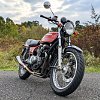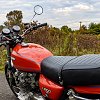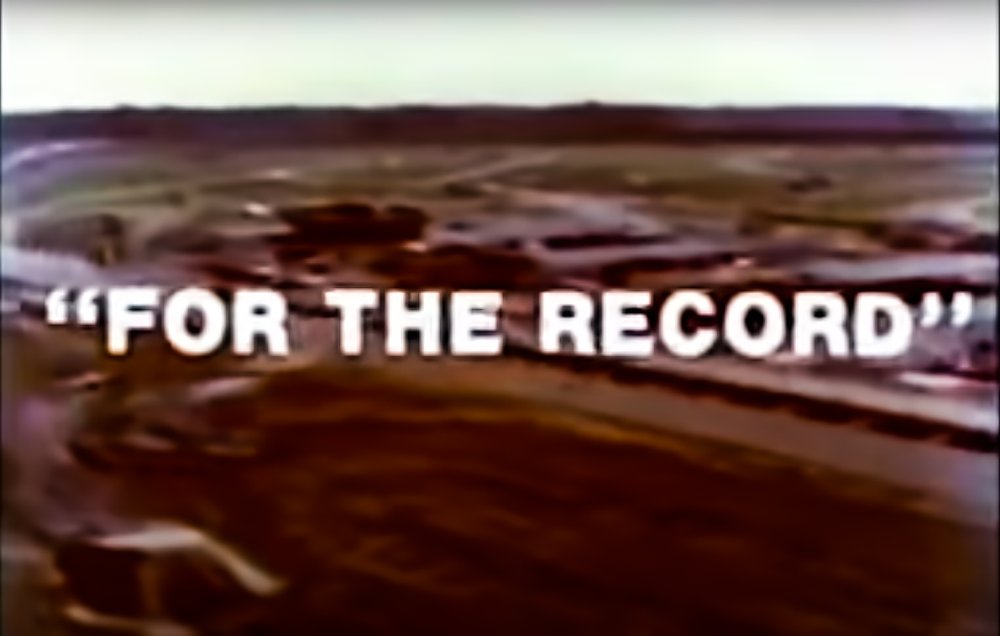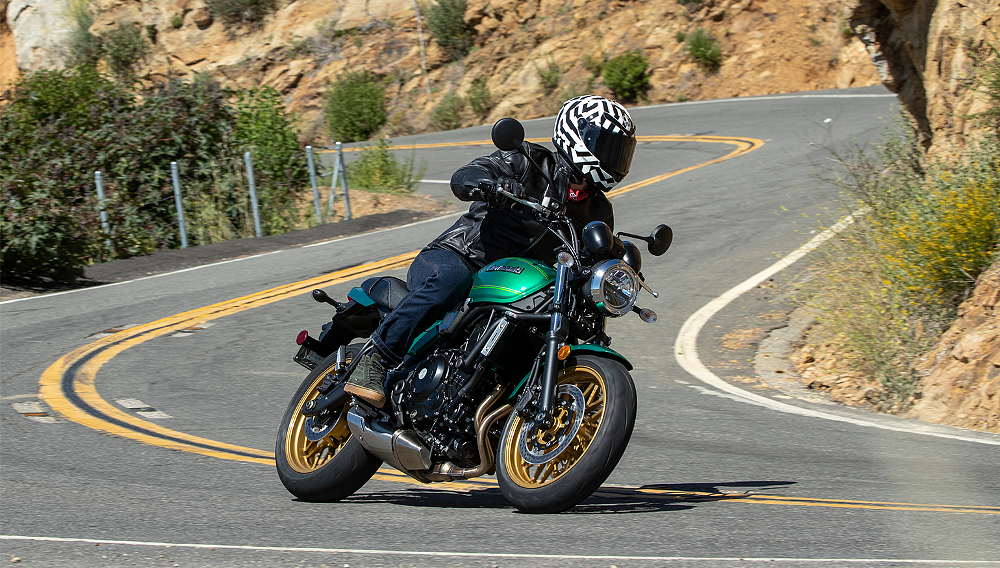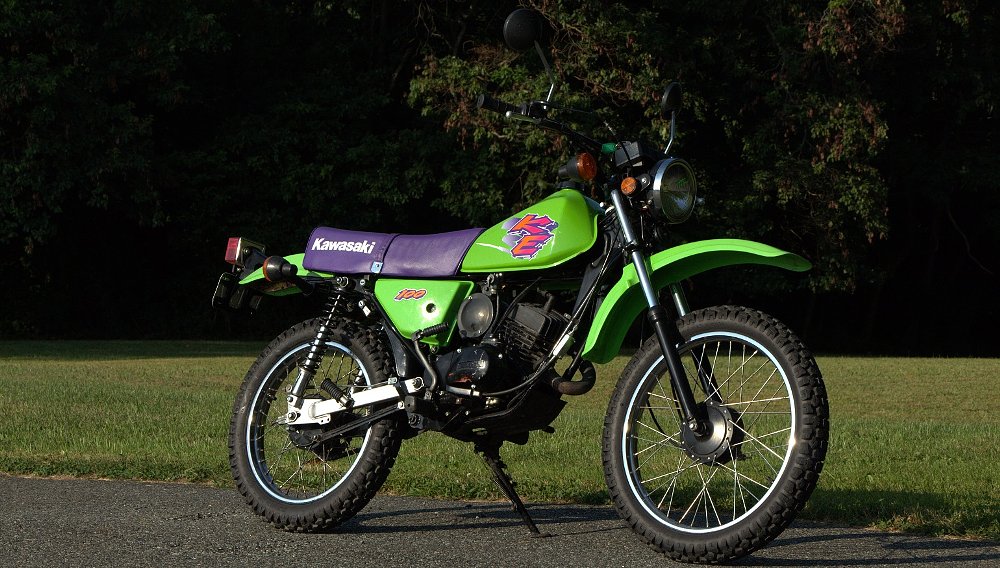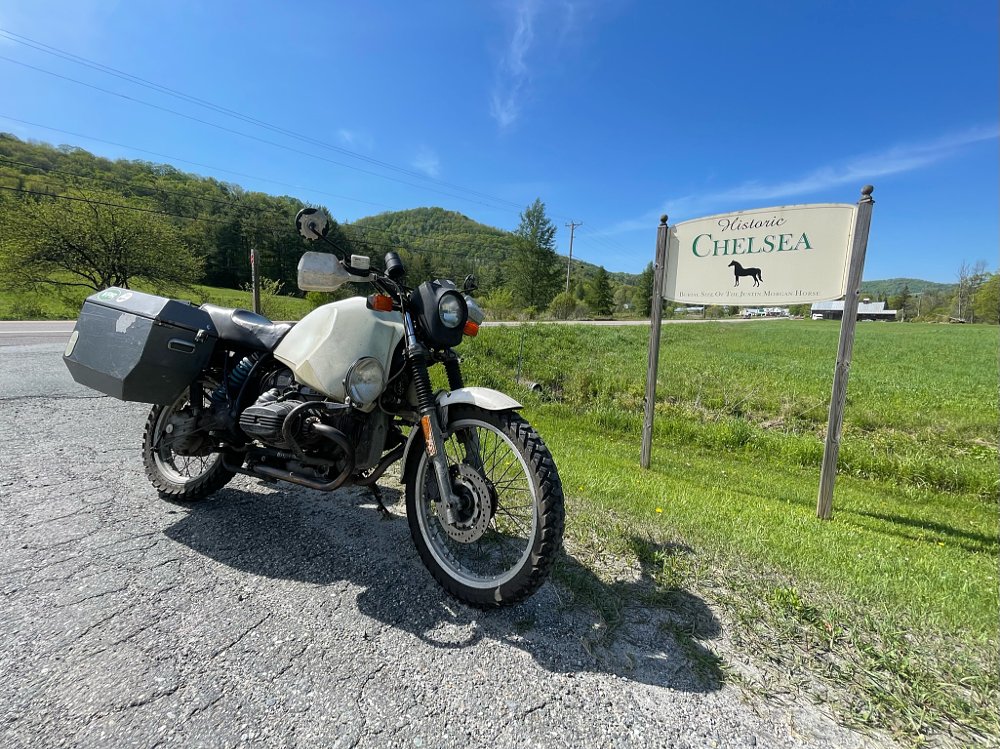The Kawasaki KZ650 was never king of anything except bang for buck. I think it’s somehow fitting that the same holds true today. Lots of riders would rather have a Goldilocks machine than the baddest bike in town.
The KZ650 never stopped being a sturdy, straightforward standard motorcycle with enough power for modern road riding and a cherry of an engine. It’s as sensible as vintage motorcycles come, and you can add one to your garage without asking the bank for yet another vehicle loan. While Z1s and early Honda CB750s shoot up in value, KZ650s are appreciating on a much gentler curve because they were never the halo bikes.
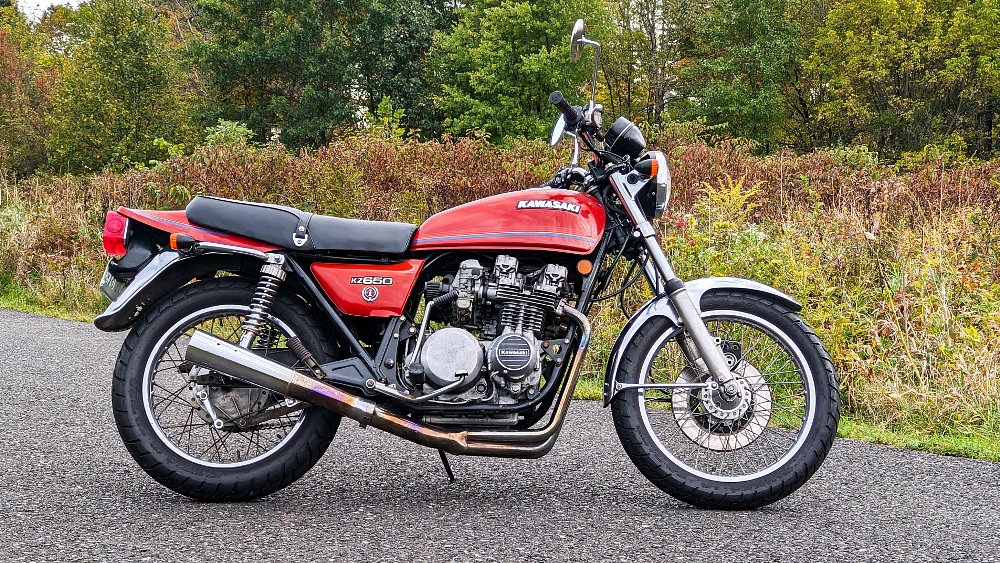
1976: Kawi's king gets a prince
Kawasaki’s 903 cc Z1 was sometimes called the king of motorcycles when it was introduced in 1972. The raucous Z1 was larger, faster, and more aggressive than Honda’s groundbreaking CB750, just as Kawasaki hoped. The Z1’s success inspired Kawasaki to build a smaller follow-up model that would be easier to buy and ride. This “large middleweight” concept became the KZ650 under the guidance of Gyoichi “Ben” Inamura — the very same man who designed the Z1. And if the Z1’s mission was crushing the 750 cc class from above, the KZ650 would sneak up from behind for a pincer attack. Kawasaki wanted to build a bike that offered the power of larger motorcycles in a package as light and flickable as a 500 cc four. Lessons learned from the Z1 refined this 650, and some creative cost-cutting measures meant the bike could attract price-conscious customers without sacrificing Kawasaki’s newly won reputation in the four-stroke street bike arena.
Inamura started with a completely fresh engine design instead of sleeving down a bulky Z1 engine. The air-cooled KZ650 has dual overhead cams, two valves per cylinder, and a hy-vo chain running off the crank instead of the Z1’s conventional gear-driven design. The one-piece crankshaft rides on plain bearings rather than the Z1’s roller bearings. Keep in mind that a double-cam engine was still a big deal at the time.
The Z1’s shim-over-bucket valve adjustment design occasionally ejected shims at high revs, which is a non-good situation, so the KZ650 moved them safely under the buckets. This made valve adjustments more difficult, but it reduced chances of catastrophic engine failure near redline. That's part of the reason why so many survive today. The KZ650 has a five-speed transmission, a high-pressure wet sump oil system, and a rack of four carburetors that are sorta easy to remove and service. Claimed horsepower was 64 eager ponies at 8,500 rpm back when these motorcycles were new.
The first production models were the 1977 KZ650B1s, available in Candy Emerald Green and Candy Super Red. (My B1 has Candy Super Red paint with a blue stripe added by a groovy previous owner.)
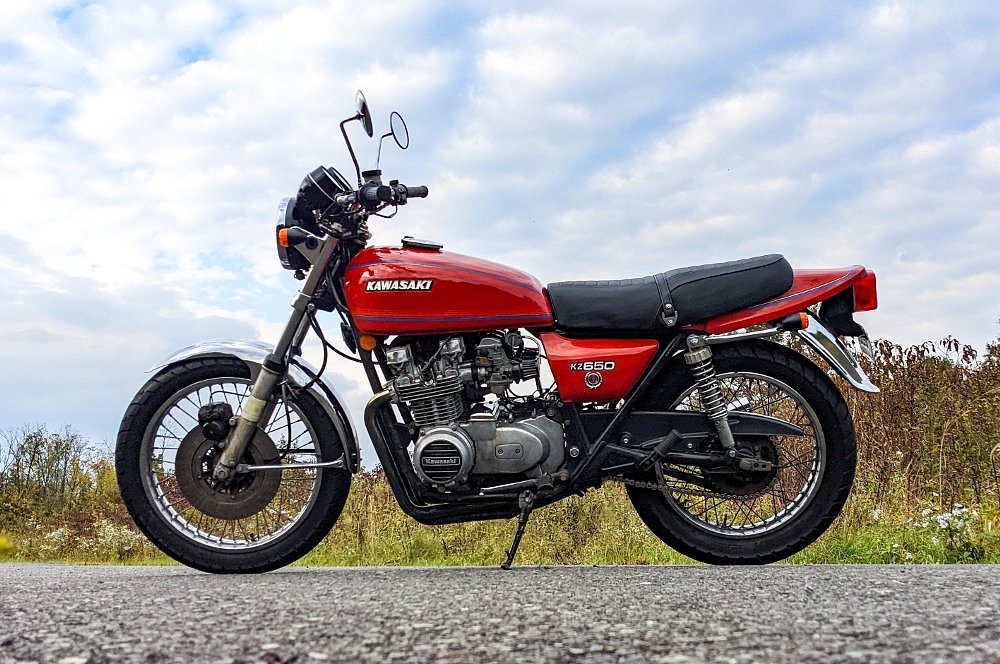
KZ650 frames actually use larger diameter tubing than the Z1s, and more frame gussets are included from the factory, so the sharper chassis pairs well with the free-revving engine. There’s a plush seat with two passenger grab rails, a tidy cockpit, and all the roominess of a big-bore machine. Later variants added cast alloy wheels, different braking setups, and even some cruiser-ish styling. The 650 engine was later bumped up to a 750, and its last descendant was the 1999-2004 ZR7 standard. That means this engine design was produced in some form or another for 28 years, or roughly a quarter of motorcycling's history.
The KZ650 is the poster child of the Universal Japanese Motorcycle, or UJM. It has all the essentials: an across-the-frame four, a steel double-cradle frame, and standard ergos. CB, KZ, GS, XS… I’ve tried all of ‘em. So why is the KZ650 the first one I added to my garage? Besides the friendly low price?
This is a classic motorcycle that I can thrash without worrying about it. I’ve been telling anyone who will listen that the GPz550 is the best dollars-to-donuts buy in vintage motorcycling, but now I'm reconsidering that position. Today's retrospective review is for the cheapskates who just want to ride something old a little too fast. Over and over again.
How cheap is a KZ650?
$3,000 should land you a very decent specimen. Running, rideable KZ650s still change hands for $1,500 or less (like mine), but it’s worth spending a bit more if it means avoiding half-finished café racer conversions and moneypit barn finds. Bring a flashlight to look around the tank for rust. How are the carbs? Do they have cheap pod filters? If you want to go back to the stock setup, original airboxes in good condition are increasingly hard to find. My KZ came with common aftermarket mods like pods, smaller turn signals, a four-into-one exhaust, adjustable rear shocks, and a DynaTek electronic ignition. I’ll probably keep all of it except the pods and turn signals.
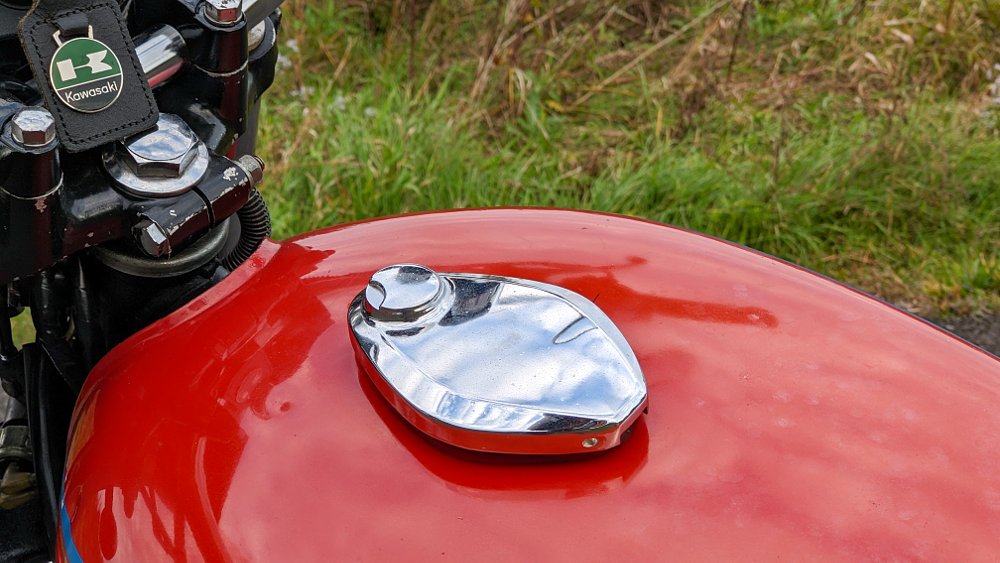
Kawasaki bills its new Z650RS parallel twin as the spiritual successor to the old KZ650s. The modern version costs $8,999. (I rode and reviewed that motorcycle earlier this year.) A new KZ650 was $2,000 back in 1977, which is roughly $9,750 today. Consider that the Z650RS weighs 413 pounds wet against the KZ650’s 485 pounds, and the RS only makes three more horsepower. Considering the 45-year difference, that makes the KZ650 seem pretty far ahead of its time, doesn't it?
Riding the KZ650
Those of you familiar with UJMs will feel right at home aboard a KZ650. For the uninitiated, this motorcycle will feel substantial, if a bit ponderous, as you pull it off the sidestand. That's when any motorcycle’s weight is felt most, and I’m not gonna sugarcoat it: This is not a light motorcycle by modern standards. Give it a chance and poke the starter. Did you remember to give a little choke?
The KZ gives the same view of the road as you’ll find on any UJM. Kawasaki claims the experience was a little better thanks to gauges that smoothed out needle movement, at least compared to instruments on other motorcycles that bounced around like metronomes. The needles do, in fact, sweep cleanly around their dials for me.
An old KZ650 approaching redline is a beautiful sound. The same KZ idling, especially if the carbs aren’t balanced, can make mechanics cringe if they haven't worked on one before. The hy-vo chain makes a rattling noise you won’t hear in other UJMs with gear primaries. Give the bike an idle adjustment and a carb sync to cut down on the ruckus. I almost walked away from this KZ before learning that those sounds were normal and manageable.
Just about every middleweight 650 today is good for 60-odd horsepower, so the KZ650 feels totally appropriate for road use today. Doesn’t hurt that it returns respectable fuel economy on the cheapest gas you can feed it. A good looking-over and tuneup should give you a reliable daily rider. Inamura’s engine is tougher than a two-dollar steak and downright entertaining — a desirable combination, and hopefully one that translates to more time riding than wrenching. I don’t worry much when I ride this motorcycle hard. Heck, the KZ will give a respectable performance against the majority of modern 650 cc street bikes until the pace gets serious. The KZ is also forgiving for riders learning the UJM ropes. Smooth carburetion and limited top-end power make the bike predictable. And there are plenty of performance upgrades, if that's your preference.
A KZ650 is chucked into corners by loading up the skinny front fork with some braking until a firm suggestion to the handlebar tips the bike in. Although it isn’t nearly as nimble as a modern 650, wavering a bit at times, it's easy to make slight adjustments to the throttle, brakes, or lean angle while razing your favorite roads, and that makes the KZ… not terrifying. Better brakes and a stiffer swingarm would probably help, but do you need that nth degree of performance to have fun on this bike? A KZ650 is fun to ride because it’s so easy to push it to its limits. It forces you to really start thinking about your lines and braking, just to see it shine a little more. Call it a rewarding experience.
The soundtrack my example makes isn’t quite the same as a stock KZ’s. Factory pipes are one of the few mega expensive parts for these motorcycles, which is part of the reason why so many of them have aftermarket four-into-one exhausts now. Revving the KZ out is a treat. I think the exhaust will be just right for me after I get around to repacking it.
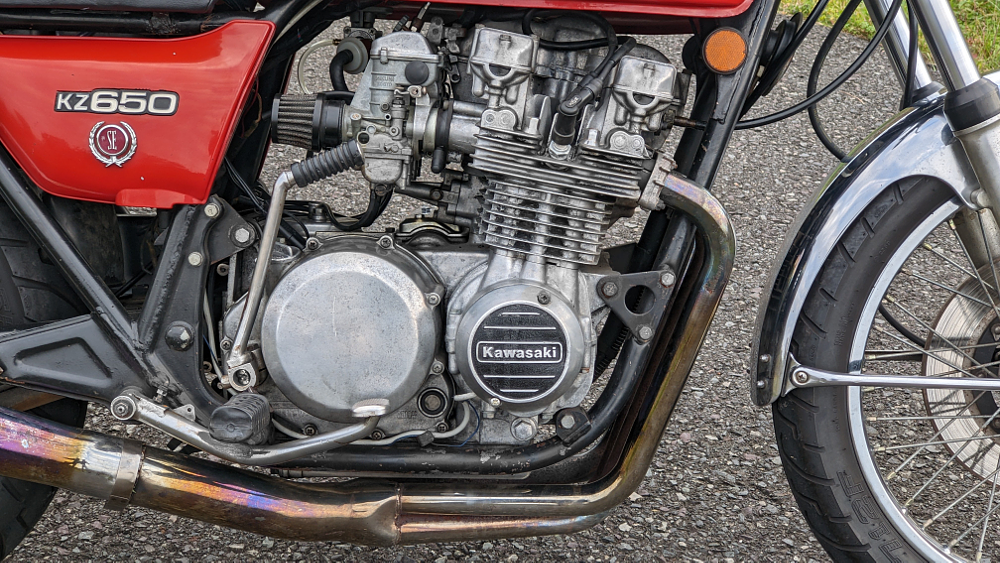
The engine is a whirring, tapping, yowling thing that just wants to sing soprano. Riding in the midrange offers good power with enough reserves to make a pass or charge a hill. Smooth fours like this are nice for engine braking, and you can’t help but appreciate the decel wind-down with the exhaust burbling away. The mirrors go fuzzy from 5,000 rpm to 6,500 rpm with the heaviest vibrations.
Compared to a CB750 or an XS750, its designated targets, the KZ650 feels lighter and more eager to rev. Straight-line speed and stability still go to the bigger machines by a small margin. I think the KZ delivers a very similar experience in a lighter, tighter package. Consider this: A stock KZ650 is about 30 pounds lighter than a CB750 and 65 pounds lighter than an XS750. (All weights claimed, wet.) Halfway up fifth gear, the KZ650 will cruise at 65 to 70 miles per hour. A 4.4-gallon tank means you won’t spend too much time looking for gas, and mileage per gallon ranges from upper 30s to low 50s depending on riding habits, mods, and general state of tune. A surprisingly usable classic, kind of like a Datsun 240Z.
KZ650 running gear
Almost every KZ650 front end needs attention today. Change the putrid fork oil, replace seals and bushings, inspect the steering head bearings, and then you can weigh judgment on this motorcycle’s handling. The primitive telescopic fork can get the job done with a little TLC. Maybe add a brace and RaceTech emulators if you have the cash, but the factory fork isn’t worth any upgrading beyond that. Dual-disc conversions are popular. I probably won’t do any more than a fluid flush, fresh pads, and a new brake line once it arrives. The rear brake is an unremarkable drum.
The adjustable aftermarket shocks that came with my example (likely KYBs) skew my handling thoughts a bit. I’m sure all the original KZ shocks you’ll see are clapped out. Unless you’re going for a concours restoration, you won’t regret new rear suspension from any number of manufacturers. My KZ’s upgraded shocks handle all the abuse Pennsylvania’s roads can throw at them, and that’s saying something.
The best money you can spend on one of these bikes is a set of modern tires. Mine came with these Shinkos, which are perfectly fine for now. I wonder what a set of Avon RoadRiders would do for the handling. The chromed steel rims take standard 19/18 vintage tire sizes, so you’ll have plenty of options. Aluminum rims are an easy way to drop unsprung weight.
I threw a reproduction seat cover and a BikeMaster Daytona handlebar on this bike to get it back to stock-ish form. It’s a better fit for me, too, at six feet tall with longish arms. The KZ650 absolutely feels like a full-size motorcycle from the saddle. The back half of the rear seat has the slightest step to it, and it’s plenty wide for a passenger or some bags. A KZ650 will schlepp you, your pillion, and a weekend duffel with a lot more ease than the twins of the day.
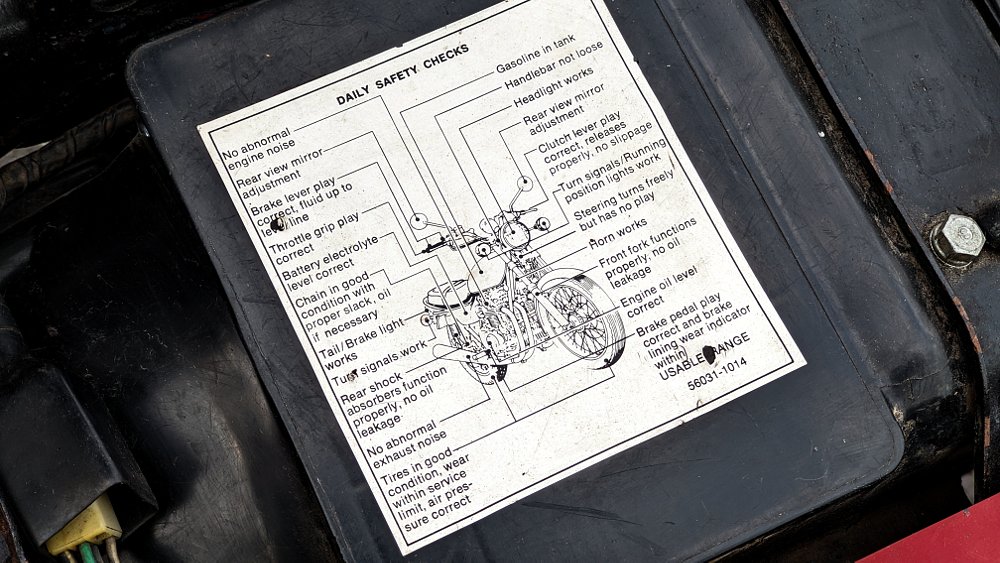
Under the seat, you should find a tool kit tray and a document holder. Kawasaki also included a decal of all the recommended safety checks. Not a bad idea, especially half a century later. The KZ doesn’t have any other notable features besides the kickstart backup that's best used for hot starts.
Despite the spec sheet similarities, can you really compare the KZ650 to Team Green’s new Z650RS? I think the two bikes could ride together for a day, no problem. Not bad for an antique.
Common KZ650 problems and pitfalls
It’s true that vintage motorcycle ownership means there’s always a chance of mechanical trouble. Stout as the KZ650 may be, a popped glass fuse 50 miles from Peoria is always a possibility, and you’ll have a hard time finding exact replacements at the local auto parts place. Consider swapping out the glass fuses for modern blade fuses, and always carry spares either way. The starter clutch innards are another weak point. You can clean or rebuild the mechanism without removing the engine from the frame.
Another thing to watch out for are the valve cover gaskets and half-moon seals that harden and leak with age. Swingarm bushings (or needle bearings on later models) and wheel bearings should be checked for excess play. The steering head bearings probably haven’t seen grease since the Travolta film hit theaters, and you’ll want to make sure the charging system is doing its job before trusting your KZ beyond the end of the driveway. Installing a new seat cover over the seat pan's spikes can be fiddly. Oh, and get some fresh spare keys. Original keys are thin and prone to breaking off in locks.
Which KZ650 should you buy?
KZ650Bs in red or green seem to be the most desirable today, closely followed by the KZ650D with its cast wheels and triple disc brakes. The cruiser-styled variants have goofy wheel sizes and plain rear fenders in place of the iconic Kawi duckbill, but they are easier to find in better condition for lower prices. The KZ650 is a good platform for custom projects, too, if that's your goal.
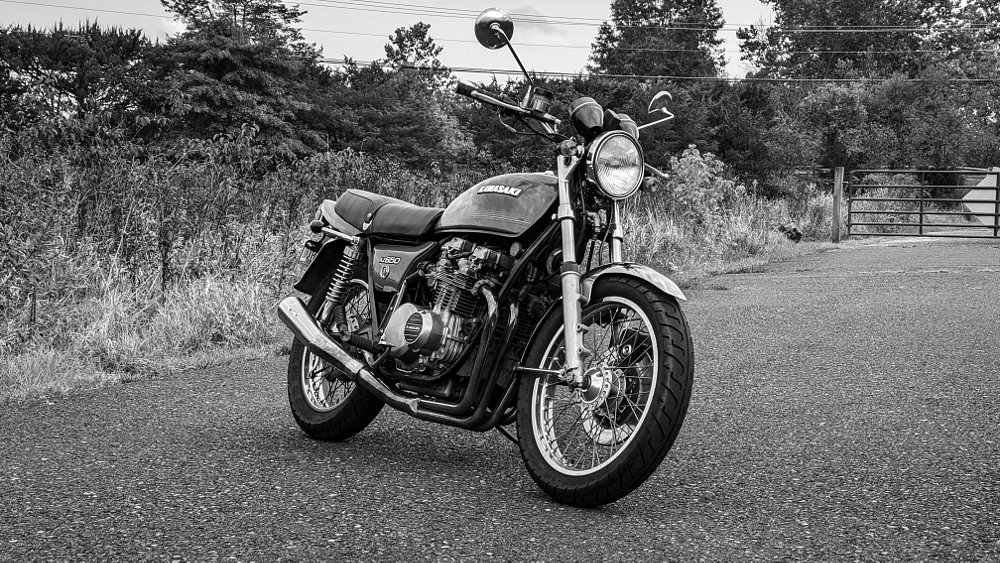
Parting thoughts on Kawi's big middleweight
The KZ650 has been a strong underdog from the beginning. Time has been kind to this artifact of simpler days. If you want a genuine classic with good manners and enough zap for regular riding, give the KZ650 a chance, especially as a second motorcycle in your garage. You can ride Kawasaki's parallel twin reissue, or you can own the original for a fraction of the price. Show me a better Japanese classic for cruising fall here in the northeast United States. This'll be my daily rider until they salt the roads for snow.






